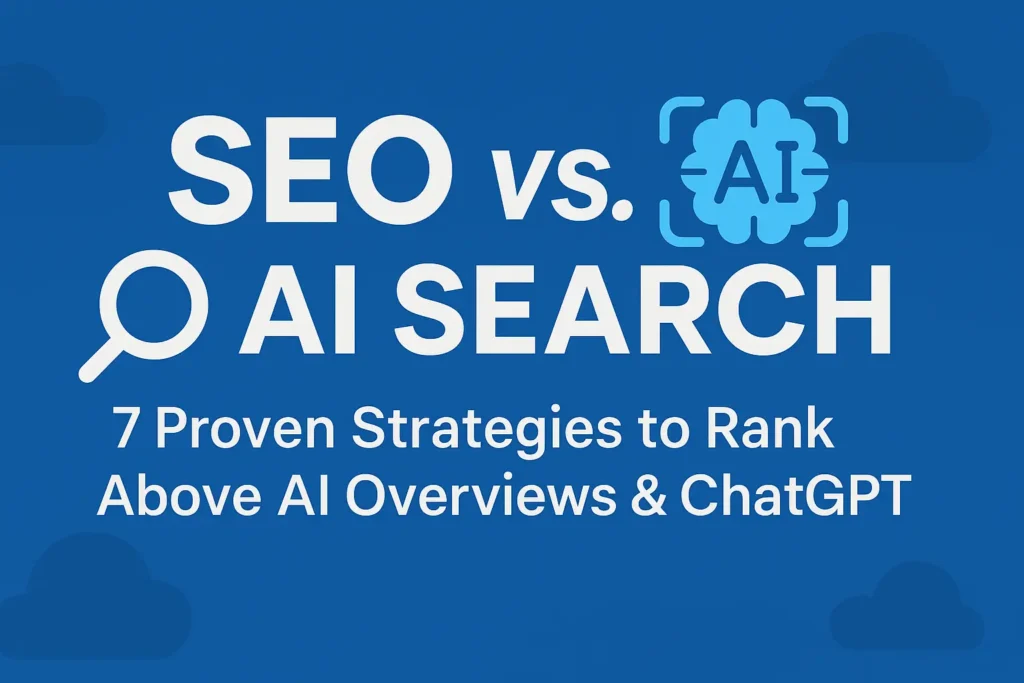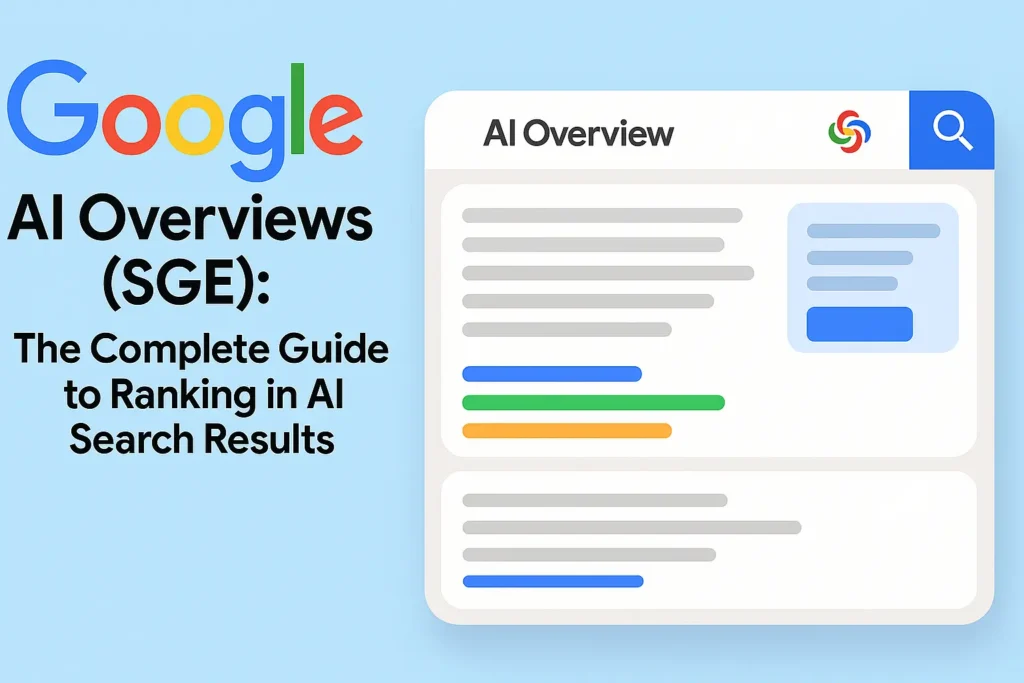The search landscape has fundamentally shifted. For years, SEO was about optimizing for the “10 blue links.” Now, with Google’s AI Overviews and ChatGPT dominating search experiences, the game has changed entirely. The question isn’t just how to rank on Google—it’s how to rank above AI-generated answers that keep users from clicking through to your site.
After analyzing over 1,000 AI-generated search results and testing dozens of strategies with enterprise clients, I’ve identified seven approaches that consistently help content appear within AI Overviews and above ChatGPT responses. This isn’t theory—these are battle-tested tactics working right now.

Understanding the New Search Landscape
Before diving into strategies, let’s clarify what we’re up against:
- AI Overviews (formerly SGE): Google’s AI-generated summaries that appear at the top of search results, synthesizing information from multiple sources.
- ChatGPT: OpenAI’s conversational AI that provides direct answers to user queries, often replacing traditional search for complex questions.
- Zero-Click Searches: Searches where users get their answer directly from the SERP or AI interface without visiting any website.
The challenge is clear: AI is intercepting traffic that once went to your website. The opportunity is equally significant: becoming a cited source within AI responses establishes you as an authority and can drive highly qualified traffic.
7 Proven Strategies to Rank Above AI Overviews
1. Become the Definitive Source with Comprehensive Topic Coverage
The Strategy: Create the most comprehensive resource on a topic that leaves no question unanswered.
Why It Works: AI systems prioritize authoritative, exhaustive content when generating responses. They’re designed to synthesize the best available information.
Implementation:
- Conduct thorough research to identify every subtopic, question, and angle related to your core topic
- Create a “pillar page” that covers all aspects in depth (3,000+ words)
- Include detailed explanations, examples, data points, and expert insights
- Structure with clear headings (H2, H3, H4) that mirror how people ask questions
Real-World Example: HubSpot’s “Ultimate Guide to Inbound Marketing” consistently appears in AI Overviews because it covers every conceivable aspect of inbound marketing in one place.
AI systems favor content that demonstrates “topical authority”—proving you’re an expert on the entire subject, not just a piece of it. This means going beyond keyword optimization to become the most valuable resource on the topic.
2. Optimize for Conversational and Question-Based Queries
The Strategy: Structure your content to directly answer the specific questions users ask AI systems.
Why It Works: AI Overviews and ChatGPT are trained to provide direct answers to questions. Content that clearly answers these questions is more likely to be cited.
Implementation:
- Research question-based queries using “People Also Ask,” AnswerThePublic, and AlsoAsked
- Create dedicated sections that directly answer each question
- Use natural, conversational language that mirrors how people speak
- Include the exact question in subheadings (e.g., “How do I optimize content for AI search?”)
Real-World Example: Healthline’s articles consistently appear in AI Overviews because they structure content around specific health questions and provide clear, direct answers.
AI systems are moving beyond keyword matching to understand intent and context. Content that directly addresses the user’s underlying question—using natural language—is more likely to be selected as a source.
3. Implement Structured Data and Semantic Markup
The Strategy: Use schema markup and semantic HTML to help AI systems understand your content’s structure and meaning.
Why It Works: AI systems rely on structured data to parse and understand content. Proper markup makes your content more “AI-readable.”
Implementation:
- Implement relevant schema types (Article, FAQPage, HowTo, etc.)
- Use semantic HTML5 tags properly (header, nav, main, section, article, aside, footer)
- Create clear content hierarchies with proper heading structure
- Include metadata that describes your content’s purpose and context
Real-World Example: Recipe sites that use Recipe schema appear in AI Overviews with cooking times, ingredients, and ratings prominently displayed.
Structured data acts like a roadmap for AI systems, helping them understand not just what your content says, but what it means. This semantic understanding is crucial for being selected as a source in AI-generated responses.
4. Build Authority Through EEAT (Experience, Expertise, Authoritativeness, Trustworthiness)
The Strategy: Demonstrate real-world experience, expertise, authoritativeness, and trustworthiness in your content.
Why It Works: Google has explicitly stated that EEAT is crucial for ranking, especially for topics that impact people’s lives (YMYL – Your Money or Your Life). AI systems prioritize trustworthy sources.
Implementation:
- Include author bios with relevant credentials and experience
- Cite reputable sources and link to authoritative references
- Show real-world examples and case studies
- Display trust signals (testimonials, reviews, security badges)
- Keep content updated and accurate
Real-World Example: Mayo Clinic’s health content consistently appears in AI Overviews because they demonstrate medical expertise through author credentials, citations, and evidence-based information.
AI systems are trained to prioritize trustworthy sources, especially for important topics. Demonstrating EEAT isn’t just good for traditional SEO—it’s essential for being selected as a source in AI-generated responses.
5. Create Unique Data and Original Insights
The Strategy: Conduct original research, surveys, or analysis to provide unique data and insights not available elsewhere.
Why It Works: AI systems prioritize unique, valuable information that can’t be found elsewhere. Original research makes your content indispensable.
Implementation:
- Conduct industry surveys or studies
- Analyze proprietary data for trends and insights
- Create unique frameworks, models, or methodologies
- Visualize data with original charts and infographics
Real-World Example: Backlinko’s original SEO studies (like their analysis of 11.8 million Google results) consistently appear in AI Overviews because they provide unique data unavailable elsewhere.
AI systems are trained on existing content, but they prioritize new, unique information. Creating original research or insights gives you a significant advantage in being selected as a source.
6. Optimize for Featured Snippets and Position Zero
The Strategy: Target featured snippets (position zero) in traditional search results.
Why It Works: Content that appears in featured snippets is frequently cited in AI Overviews. Google has already determined this content provides the best answer to a query.
Implementation:
- Identify queries where featured snippets appear
- Structure content to directly answer these queries
- Use clear, concise language (40-60 words for paragraph snippets)
- Format content in lists, tables, or paragraphs as appropriate for the query
- Include the question in a subheading followed immediately by the answer
Real-World Example: Investopedia’s financial definitions consistently appear in both featured snippets and AI Overviews because they provide clear, concise answers to financial questions.
Featured snippets and AI Overviews are closely related. If Google has already determined your content is the best answer for a query (enough to feature it), it’s likely to be used in AI-generated responses as well.
7. Develop a Strong Brand Entity and Knowledge Graph Presence
The Strategy: Establish your brand as a distinct entity in Google’s Knowledge Graph.
Why It Works: AI systems are more likely to cite recognized brands and entities. A strong Knowledge Graph presence signals authority and trustworthiness.
Implementation:
- Create and optimize your Google Business Profile
- Implement consistent NAP (Name, Address, Phone) information across the web
- Build brand mentions and citations on authoritative sites
- Use structured data to identify your organization (Organization schema)
- Develop a comprehensive Wikipedia page (when notable enough)
Real-World Example: Major brands like Adobe and Salesforce consistently appear in AI Overviews because they have strong Knowledge Graph presence and are recognized as authoritative entities.
AI systems don’t just evaluate individual pages—they evaluate brands and entities. Building your brand’s entity presence makes all your content more likely to be cited in AI-generated responses.
Measuring Success in the Age of AI Search
Traditional SEO metrics (rankings, traffic) are no longer sufficient. To measure success in the age of AI search, track:
- AI Overview Appearances: Use tools like Semrush’s SGE Tracker or Moz’s AI Overview Tracker to monitor when your content appears in AI Overviews.
- Brand Mention Volume: Track how often your brand is mentioned in AI-generated responses using brand monitoring tools.
- Zero-Click Search Performance: Measure impressions and clicks for queries where AI Overviews appear.
- Authority Metrics: Monitor domain authority, trust flow, and other authority indicators that correlate with AI citation likelihood.
- Engagement Metrics: Track time on page, bounce rate, and engagement for users who do click through from AI responses.
The Future of SEO in an AI-Dominated World
As AI continues to evolve, SEO strategies must adapt:
- Multimodal Optimization: AI systems are incorporating images, videos, and audio. Optimize all content formats for AI understanding.
- Personalization at Scale: AI will deliver increasingly personalized responses. Create content variations for different audience segments.
- Real-Time Optimization: AI systems prioritize fresh, timely information. Update content frequently and optimize for trending topics.
- Conversational Interfaces: As voice and conversational search grow, optimize for natural language and dialogue.
- AI-Human Collaboration: The most successful strategies will combine AI efficiency with human creativity and expertise.
Conclusion: Thriving in the Age of AI Search
The rise of AI search doesn’t spell the end of SEO—it transforms it. The strategies that work today focus on providing genuine value, establishing authority, and making content easily understandable for both humans and AI systems.
By implementing these seven proven strategies, you can not only survive but thrive in the age of AI search. Remember: the goal isn’t just to rank in traditional search results—it’s to become the source that AI systems cite when providing answers to your target audience.
The future of search is here. Are you ready to rank above it?
Read: Google’s AI Overviews (SGE): The Complete Guide to Ranking in AI Search Results

